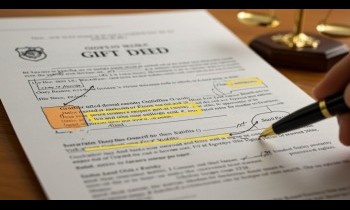What is Cheque Bounce along with its Legal Remedies?
.jpeg)
Date : 29 Apr, 2022
Post By Vishal Kumar
INTRODUCTION Cheque bounce cases are very common these days. Usage of cheques is also very common these days. The more the cheques are used, the more are the instances of cheque bounce. However, a cheque bounce is contrary to a lawful transaction between two people, and the person whose cheque bounces is liable for punishment under the law. section 138-142 of the Negotiable Instruments Act deals with the cheque bounce situations and prescribes appropriate punishment. REASONS FOR CHEQUE BOUNCE Insufficient balance in the account of the person who is writing the cheque. Signature of the drawer (person who writes the cheque) is unclear or erased or incomplete or fraudulent. The account number is written on the cheque if not discernible with the naked eye. Overwriting has been done on the cheque. If the account from which the drawer wants to take out money does not exist. SECTION 138 OF THE NEGOTIABLE INSTRUMENTS ACT Sections 138 to 142 of the act were introduced to give credibility to business transactions that happen through negotiable instruments such as cheques. These sections are penal provisions that are there to make sure that the obligations which the drawer of the cheque has towards the payee are honoured to the fullest extent. The ingredients that are required to be fulfilled under section 138 are- A person must have written a cheque in favour of another person in furtherance of money that the person owes to another. The payee (the person in whose favour the cheque is drawn) has to approach the bank for the payment via the cheque within three months. The bank returns the cheque without any payment because of any of the reasons mentioned above. The payee then has to send a legal notice to the drawer demanding payment of the money. The drawer does not pay the required sum of money. PROCEDURE FOLLOWED UNDER SECTION 138 If the drawer does not pay the money within 15 days after the legal notice has been sent to him, the payee can file a criminal complaint against the drawer of the cheque in the magistrate court of competent jurisdiction under section 138. If the court is satisfied with the claims made by the payee, then the court calls upon the drawer by issuing a summons. If the drawer refuses to appear in court, then the court can issue a bailable warrant against him. If the accused does not turn up in court even after the issuance of a bailable warrant, the court can issue a non-bailable warrant to secure the presence of the drawer. If the accused pleads guilty, the court sentences him and if the accused pleads not guilty, the accused is given a copy of the complaint made out against him. Both the parties are then cross-examined and they can produce their evidence. The court passes the judgement which is subject to appeal by either party. CIVIL SUIT FOR CHEQUE BOUNCE A civil suit can be filed by the complainant against the drawer under order 37 of CPC. In such cases, a summary suit under Order 37 of CPC can be filed in a civil court. Such summary suits are only filed in cases of recovery of money etc. a basic difference between a criminal complaint and a civil complaint of cheque bounce is that in the criminal complaint, the drawee wants to recover the amount and punish the drawer for the non-payment but in the civil complaint, the focus is solely on recovering the amount. DOCUMENT REQUIRED TO FILE COMPLAINT OF CHEQUE BOUNCE Unpaid cheque slip returned by the bank of the drawee. The legal notice which was sent to the drawer. The response to that notice Invoice The original bounced cheque and its copy. PUNISHMENT FOR CHEQUE BOUNCE Imprisonment which can extend to 1 year. Recovery of cheque amount or double. Both VICARIOUS LIABILITY OF DIRECTORS OF COMPANIES WHEN THE CHEQUE BOUNCES The honouring of cheques does not only depend on materialistic factors such as signatures and account holder’s name and insufficient balance but also depends on the credibility of the drawers and their integrity and honesty. Bouncing a cheque can cause a huge amount of loss which is financial and also causes a lot of time wastage of the payee. A company is an artificial legal entity that runs through its owners and directors. When a cheque is drawn by a company bounce, the primary onus doesn’t only fall on the company but also on its directors. Section 141 of the Negotiable Instruments Act talks about offences of the company, which also makes the directors vicariously liable. E-CHEQUE SYSTEM Amendments took place in the Negotiable Instruments Act which added section 81 A to the act. With this amendment, the E-CHEQUE system is now legalised in India. There were a lot of advantages that came with the e-cheques such as a cheque that never bounces due to insufficient balance and where the creditor does not have to be physically present at the bank etc. ANALYSIS OF SECTION 138 There is no doubt that with the increasing commercialisation in the world, the advent of cheques is deemed to happen. People do not want to keep the currency with them and instead prefer keeping cheque booklets which can help in fluent transactions. Transactions in cheques have increased and so has the bouncing of cheques. Before the Negotiable Instrument Act, the cheque bounce did not have a very stringent punishment and the law was not very effective. Due to this, the payee used to suffer from an incalculable number of losses with no legal recourse. To ensure the payment of the amount and remedy when the cheque is dishonoured, the act was introduced. The scope of section 138 is that the cheque bounce is not always intentional. But there are some situations of strict and absolute liability under which mens rea is not needed. The language of section 138 signifies the principle of mens rea because the law understands the toll it takes on the payee in such circumstances. CASE LAWS Dayawati v. Yogesh Kumar Gosain- In this case, the court took into account the fact that the offence under section 138 can also be solved by mediation. The offence under section 138 is compoundable and no provision in the law provides for the criminal trial of cases specifically. Dashrath Rupsingh Rathore v. the State of Maharashtra- In this case, the court held that the criminal complaint has to be initiated at the place where the bank is located in which the payee went to encash the cheque. Before this case, the initiation of the complaint was at the residence or place of business of the holder of the cheque. Meters and Instruments (P) Ltd. v. Kanchan Mehta- In this case, the court held that the offence committed under section 138 is a civil wrong and the compensation awarded under section 138 is punitive. The court will not stop the parties from compounding the offence at an initial stage or a later stage. RECENT AMENDMENT TO THE ACT The drawer of the cheque will pay interim compensation to the payee to the tune of 20% of the amount of the cheque. The interim compensation has to be paid within 60 days from the date of the order passed by the court. If the court finds out that the drawer of the cheque was not responsible for anything and is acquitted, then the drawee has to pay back the compensation with interest. CONCLUSION Cheque bounce has to be considered as both civil and criminal wrong and filing in one court will not debar the filing of a case in another court. This means that even if the case has been filed in a civil court, a subsequent criminal complaint can be filed. In the event of any dispute, the recent judgement and amendments have become more equipped, but at the same time, situations like frivolous appeals, and arbitrary adjournments to proceedings can cause a delay in the payment of the cheque. This is still very harmful to the payee in many respects and the law needs to expand its scope to tackle these situations. WHY LAWTENDO? Lawtendo is a platform for you to help in hiring legal counsel. We work twenty-four hours to provide the best lawyers who suit the needs of the customers. We work with a wide range of lawyers whose areas of expertise range from divorce, court marriage, and registration, property possession delay, cheque, and money recovery; to will drafting and agreement, employment issues, and builder disputes. In addition to this, we also deal with cases of wrongful dishonour of cheques. Lawtendo is a hassle-free platform that works rigorously to make sure the best lawyer reaches their client in time. Written by Tarushi Goel, a fifth-year law student of O.P Jindal Global University. She is currently pursuing BA LLB and is inclined toward legal research.





